句子基本成分和基本句型讲解(课件)通用版英语六年级下册(共46张PPT)
文档属性
| 名称 | 句子基本成分和基本句型讲解(课件)通用版英语六年级下册(共46张PPT) | 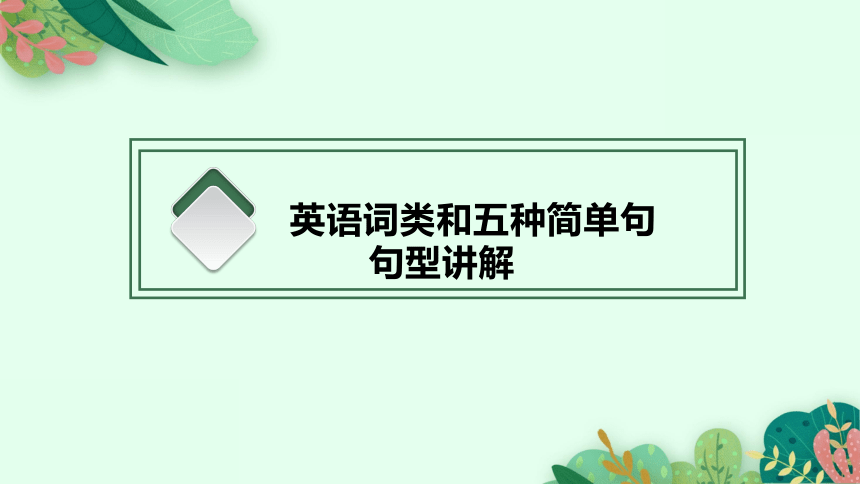 | |
| 格式 | pptx | ||
| 文件大小 | 999.4KB | ||
| 资源类型 | 教案 | ||
| 版本资源 | 人教版(PEP) | ||
| 科目 | 英语 | ||
| 更新时间 | 2023-08-24 09:18:08 | ||
图片预览

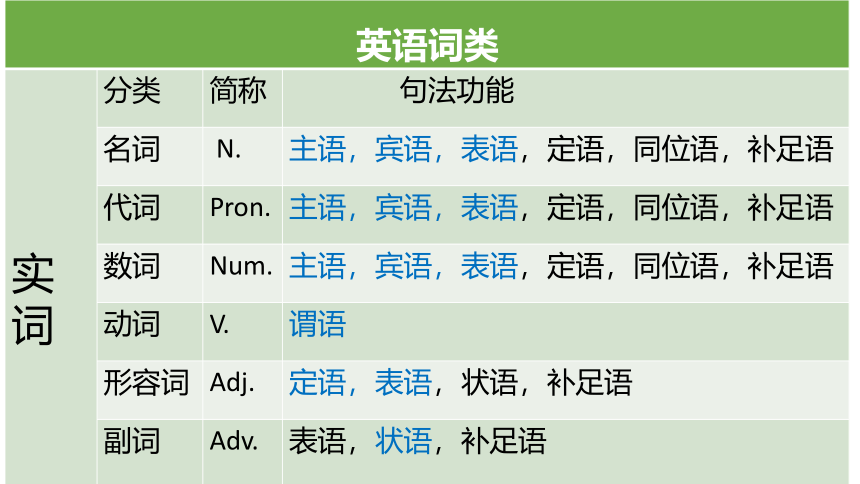
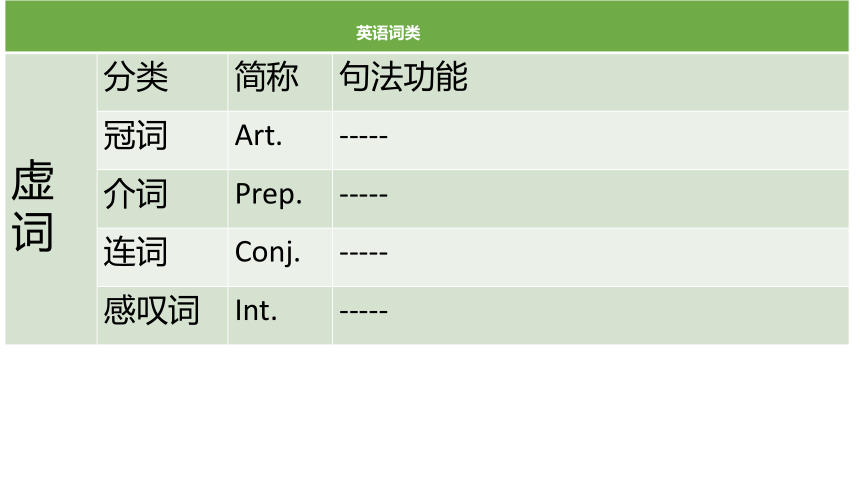
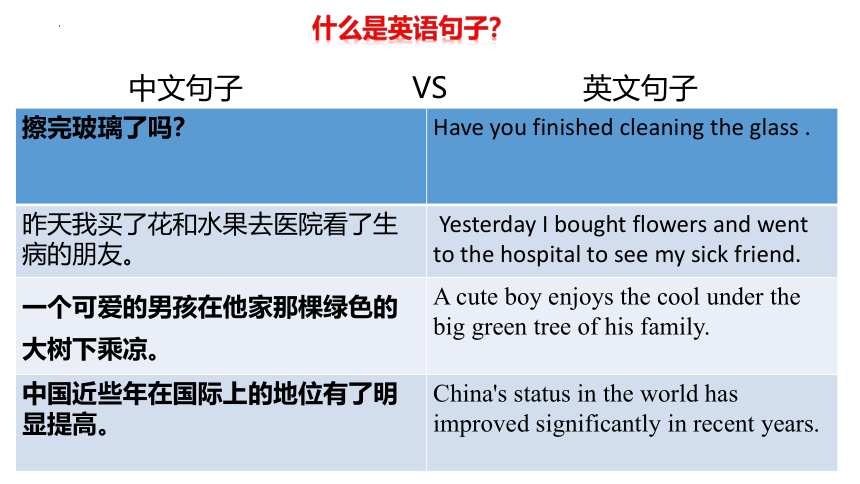
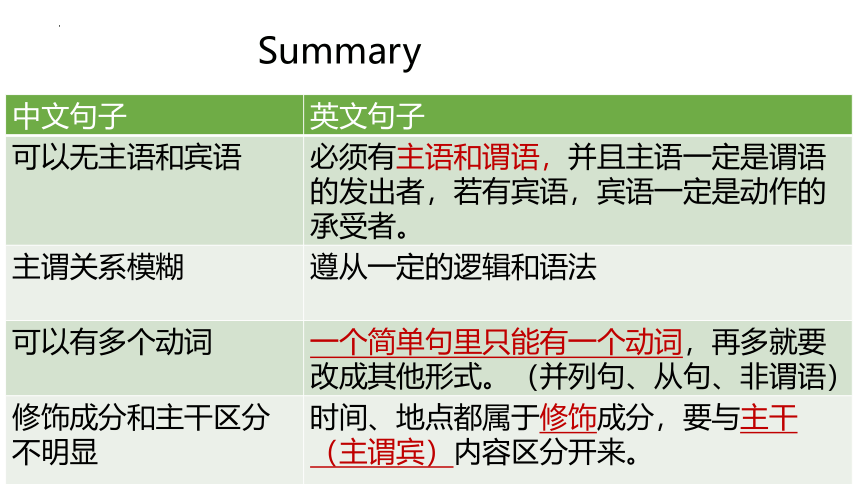
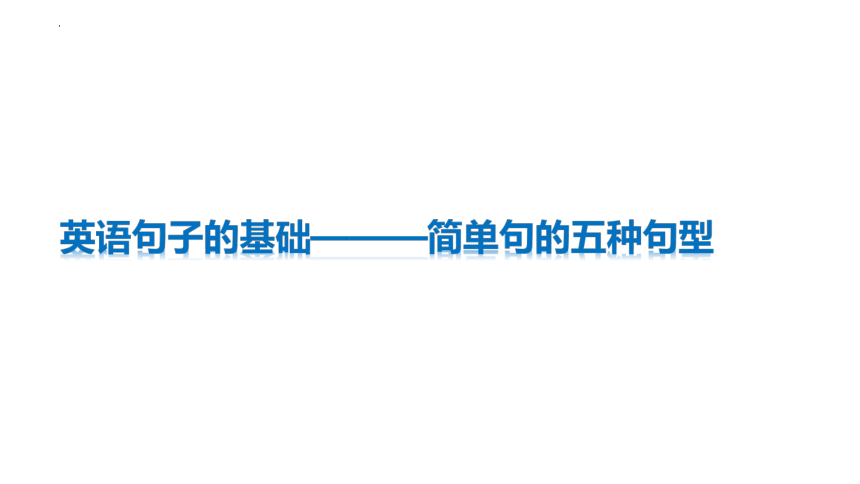

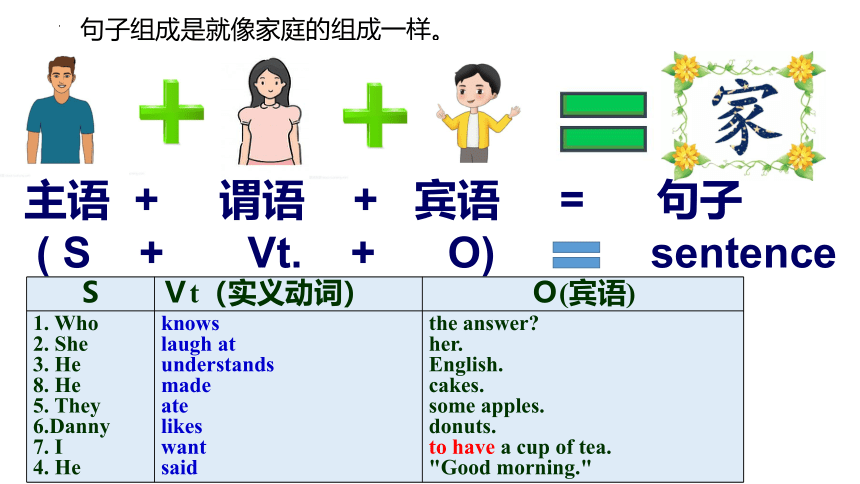
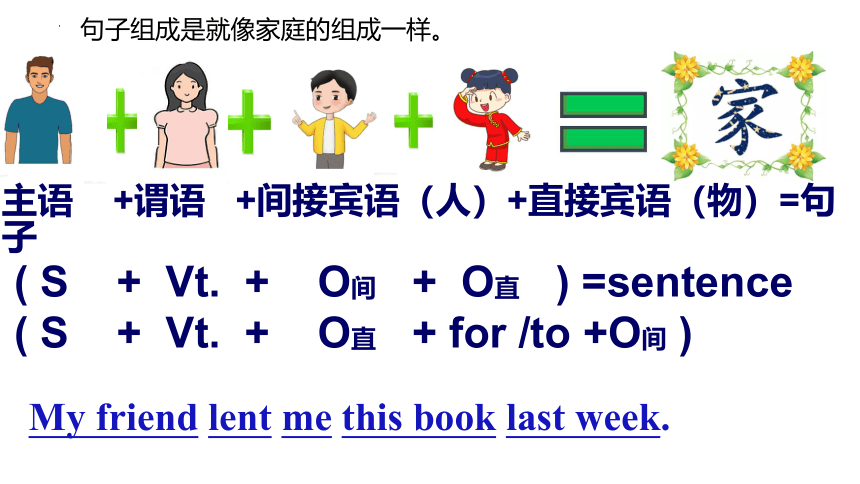

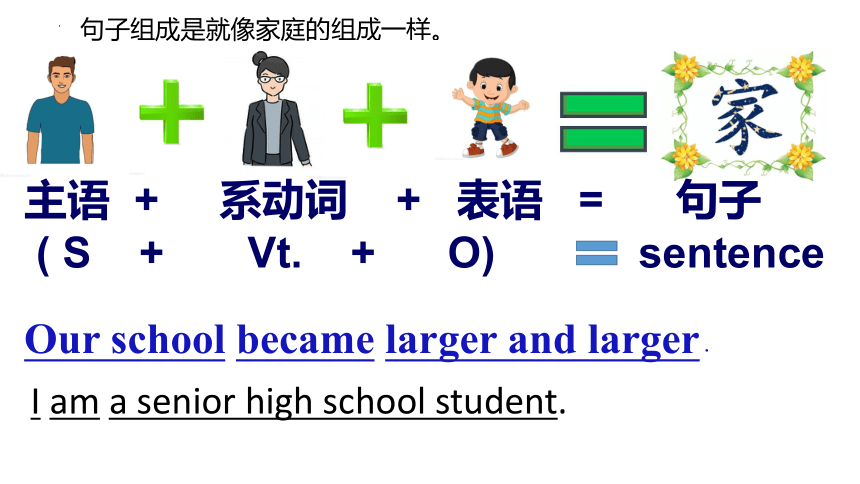
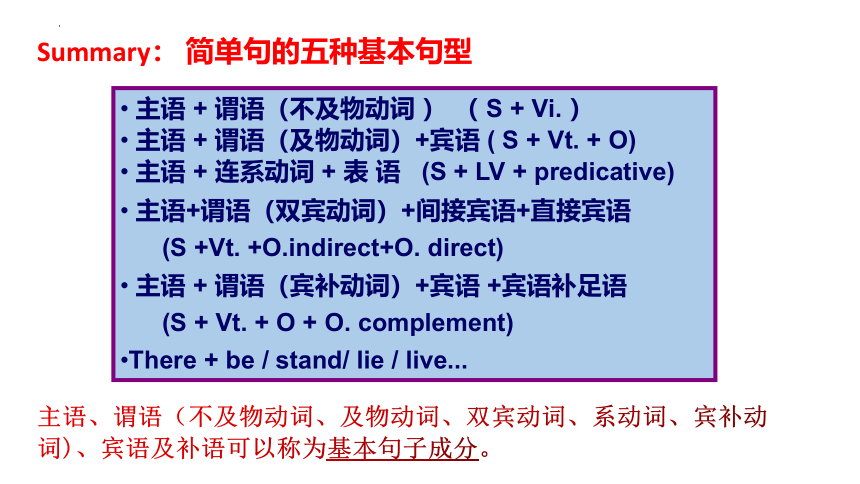
文档简介
(共46张PPT)
英语词类和五种简单句
句型讲解
英语词类
实词 分类 简称 句法功能
名词 N. 主语,宾语,表语,定语,同位语,补足语
代词 Pron. 主语,宾语,表语,定语,同位语,补足语
数词 Num. 主语,宾语,表语,定语,同位语,补足语
动词 V. 谓语
形容词 Adj. 定语,表语,状语,补足语
副词 Adv. 表语,状语,补足语
英语词类
虚词 分类 简称 句法功能
冠词 Art. -----
介词 Prep. -----
连词 Conj. -----
感叹词 Int. -----
什么是英语句子?
中文句子 VS 英文句子
擦完玻璃了吗? Have you finished cleaning the glass .
昨天我买了花和水果去医院看了生病的朋友。 Yesterday I bought flowers and went to the hospital to see my sick friend.
一个可爱的男孩在他家那棵绿色的大树下乘凉。 A cute boy enjoys the cool under the big green tree of his family.
中国近些年在国际上的地位有了明显提高。 China's status in the world has improved significantly in recent years.
Summary
中文句子 英文句子
可以无主语和宾语 必须有主语和谓语,并且主语一定是谓语的发出者,若有宾语,宾语一定是动作的承受者。
主谓关系模糊 遵从一定的逻辑和语法
可以有多个动词 一个简单句里只能有一个动词,再多就要改成其他形式。(并列句、从句、非谓语)
修饰成分和主干区分不明显 时间、地点都属于修饰成分,要与主干(主谓宾)内容区分开来。
英语句子的基础———简单句的五种句型
句子的组成是就像家庭的组成一样。
主语 + 谓语(不及物动词)= 句子
( S + Vi. ) sentence
S Vi (不及物动词)
1. Time 2. The moon 3. She 4. They 5. He flies.
rose.
sings beautifully.
talked for half an hour.
walked yesterday
句子组成是就像家庭的组成一样。
主语 + 谓语 + 宾语 = 句子
( S + Vt. + O) sentence
S Vt(实义动词) O(宾语)
1. Who 2. She 3. He 8. He 5. They 6.Danny 7. I 4. He knows laugh at understands made ate likes want said the answer
her.
English.
cakes.
some apples.
donuts.
to have a cup of tea.
"Good morning."
句子组成是就像家庭的组成一样。
主语 +谓语 +间接宾语(人)+直接宾语(物)=句子
( S + Vt. + O间 + O直 ) =sentence
( S + Vt. + O直 + for /to +O间 )
My friend lent me this book last week.
句子组成是就像家庭的组成一样。
主语 + 谓语 +宾语 + 宾语补足语 =句子
( S + Vt. + O + O. complement) sentence
I found him lying in bed.
句子组成是就像家庭的组成一样。
主语 + 系动词 + 表语 = 句子
( S + Vt. + O) sentence
Our school became larger and larger
.
I am a senior high school student.
主语 + 谓语(不及物动词 ) ( S + Vi. )
主语 + 谓语(及物动词)+宾语 ( S + Vt. + O)
主语 + 连系动词 + 表 语 (S + LV + predicative)
主语+谓语(双宾动词)+间接宾语+直接宾语
(S +Vt. +O.indirect+O. direct)
主语 + 谓语(宾补动词)+宾语 +宾语补足语
(S + Vt. + O + O. complement)
There + be / stand/ lie / live...
Summary: 简单句的五种基本句型
主语、谓语(不及物动词、及物动词、双宾动词、系动词、宾补动词)、宾语及补语可以称为基本句子成分。
点击添加文本
点击添加文本
点击添加文本
点击添加文本
2
九种句子成分
I met my best friend Tom at the station
↓
主语
↓
谓
语
↓
定语
↓
宾
语
↓
同位语
↓
状
语
句子成分的构成
句子的主干成分:
主语、谓语、宾语、表语
句子的次要成分:
定语、状语、补语(宾补、主补)、
插入语、同位语
主语(subject)
1. 主语是句子陈述的对象。
2.一般在句首。
3. 一般由名词,代词或相当于名词的词或短语充当。
1. We study in No. 7 Middle School.
2.The classroom is very clean.
3.To teach them English is my job.
4.Surfing, diving and swimming are all water sports.
5.Four plus four is eight.
6.What he has said is true.
7.The young should respect the old.
代词
名词
不定式
动名词
数词
从句
(the+adj表示一类人)
谓语(verb)
1. 表示主语的动作行为。
2. 必须由动词充当。
3.一般在主语后面。
(1) 简单谓语: 是由动词或动词短语构成的。
We study hard.
He often listens to music.
(2) 复合谓语:由“情态动词或助动词 + 行为动词”构成。
He can speak English.
We have finished the task.
I did see her yesterday.
实义动词
系动词
情态动词
助动词
(V.)
1)状态系动词,用来表示主语状态,只有be(am, is, are, was, were, been, being)一词
He is a teacher.
2)持续系动词,用来表示主语继续或保持一种状况或态度,主要有keep, remain, stay
He always kept silent at meeting.
3)表像系动词,用来表示"看起来像"这一概念,主要有seem, appear, look 例如:
He looks tired.
He seems (to be) very sad.
系动词
4)感官系动词,主要有feel, smell, sound, taste
This flower smells very sweet.
5)变化系动词,表示主语变成什么样,主要有become, grow, turn, fall, get, go, come
He became mad after that.
6)终止系动词,表示主语已终止动作,主要有prove, turn out
The rumor proved false.
这谣言证实有假。
His plan turned out a success.
他的计划终于成功了。
表语(predicative)
1. 说明主语的身份、类属、状态或特征。
2. 位于系动词后面(最常见的系动词是be)。
1.He is young.
2.I am a teacher.
3.Everybody is here.
4.My job is to teach them English.
5.Now they are at home.
6.The book is what I need.
7.He got lost in the forest.
8.His hobby is swimming.
形容词
名词
副词
不定式短语
介词短语
从句
过去分词
动名词
宾语 (object)
1. 表示动作的对象(动宾);介词涉及的对象(介宾)
2. 用在及物动词或介词后面。
She is playing the piano.
He often helps me.
We enjoy living in the countryside.
He is interested in painting.
3.动宾包括直接宾语和间接宾语。
Please pass me the book.
He bought her some flowers.
宾语补足语(object complement)
在宾语后面,对宾语进行补充说明,与宾语一起构成复合宾语。
I made my room beautiful.
I can see her dancing there.
He had his car washed.
She asked me to lend her my bike.
Please make yourself at home.
We keep the dog out.
We call her Madam.
形容词
现在分词
过去分词
不定式
介词短语
副词
名词
主语补足语(subject complement)
对主语进行补充说明。
Tom was seen dancing in his room.
I was elected monitor.
Our country will be made stronger.
定语(attribute) “……的”
用来修饰名词或代词,起类似于形容词的修饰作用。
1.He is a clever boy.
2.His father works in a shoe factory.
3.There are 54 students in our class.
4.Do you know Betty’s sister
5.His spoken English is good.
6.The girl in red is his sister.
7.I want to have something to drink.
8.The girl standing under the tree is his daughter.
9.Do you know the man who's standing there
(形容词)
(物主代词)
(数词)
(名词所有格)
(过去分词)
(介词短语)
(现在分词短语)
(从句)
(不定式)
(名词)
状语 (adverbial)
1. 修饰动词,形容词,副词或整句。
2. 表示动作发生的时间,地点,原因,目的,方式,程度,结果,条件,让步,伴随等。
1.He did it carefully.
2.She is very crazy about it.
3.He comes to see us every day.
4.He lay on the grass,looking at the sky.
5.I'll come back in a while.
6.Without his help, we couldn't work it out.
7.He was late because of the heavy rain.
8.She was beautiful when she was a girl.
同位语(apposition)
1.对前面的名词或代词做进一步解释,说明它们的性质和情况。
2.在句中和前面的名词指同一人、同一物,同做一种句子成分。
1. Tom, our monitor, is a handsome boy.
2. I myself will do the experiment.
3. She is the oldest among them six.
4. The news that he is ill worries us.
名词
反身代词
数词
从句
插入语(parenthesis)
插入语指的是对一句话所做的附加解释。其作用是,补足句意,包括说话者的态度,或引起听话者的注意。以下句子带有常见的插入语:
1. That will be a good beginning, I hope.
2. We'll have to take an umbrella, I' m afraid.
3. I have no money, you see.
4. He is a bad guy, you know.
5. Mr. Smith, I think, is at least 50 years old.
6. This, I suppose, will give you some idea of the situation in China.
点击添加文本
点击添加文本
点击添加文本
点击添加文本
3
英语句子种类
点击添加文本
点击添加文本
点击添加文本
点击添加文本
感叹句
英语句子按照用途可以分成以上四类
陈述句
疑问句
祈使句
分类1
点击添加文本
点击添加文本
点击添加文本
点击添加文本
英语句子按照结构可分为以下几种类型
由一个主语(或并列主语)和一个谓语(或并列谓语)构成的句子。
简单句
由并列连词(and,so,but,or等)把两个或两个以上的简单句连在一起而构成的句子。
并列句
由一个主句和一个或一个以上的从句构成的句子。
初中常考复合句包括:
状从、宾从和定从。
复合句
分类2
并列句(The Compound Sentence)
需把几个意思连接在一起时,可用分号或把两个或几个简单句用并列连词连接起来,这种结构即构成一个并列句。
用分号:
We fished all day; we didn’t catch a thing.
用分号,后跟一个连接副词:
We fished all day; however, we didn’t catch a thing.
用并列连词(如and、but、so、yet等)
We fished all day, but (we) didn’t catch a thing.
常用并列连词
coordinating conjunctions
平行并列连词:
转折并列连词:
因果并列连词:
选择并列连词:
and, both…and, not only…but also, neither…nor, and then
but, while, yet
for, so
or, either…or, otherwise
并列句的词序:
并列句基本上保留了简单句的词序。
主语 谓语 宾语 连词 主语 系动词 表语
Jimmy fell off his bike but (he) wasn’t hurt.
五种简单句型可用并列连词连接起来组成并列句。
主 谓 状(方式) 连 主 谓 表
Frank worked hard and (he ) became an architect.
主 谓 宾 连 主 谓 地点
I ’ve got a cold, so I ’m going to bed.
主 谓 宾 宾补 连 主 谓 宾
They made him chairman, but (they) didn’t increase his salary.
复合句(The Complex Sentence)
由一个主句和一个或者一个以上从句所构成的句子。在英语书面语中应用广泛。
主句是一个完整的句子,它可以独立存在。
从句是一个不完整的句子,它必须和一个主句连用,不能独立存在。
复合句可以通过把两个以上简单句连接在一起构成,但复合句的各组成部分并非同等重要,其中一个句子由从属连词引导(从句),用以修饰另一句子(主句)。
复合句 = 主句 + 从句
复合句是在简单句的基础上,通过从属连词将两个或两个以上简单句连接在一起而构成。从属连词所引导的从句起形容词、名词、副词的作用。复合句主要包含以下类型从句:
1. 主语从句 2. 宾语从句
3. 表语从句 4.同位语从句
5. 定语从句 6.状语从句
英文写作中最常使用的从句
宾语从句
状语从句
定语从句
复合句与简单句:复合句 = 简单句 + 从属连词 +简单句
He told me
the news.
that the match had
been cancelled.
宾语
how much he was prepared
to pay for my car.
that I could have the
money without delay.
how much he was prepared to
pay for my car and that I could
have the money without delay.
when he was
leaving for Paris.
that his father
was working in
that school.
宾语从句
复合句与简单句:复合句 = 简单句 + 从属连词 +简单句
I don’t know
him.
He has finished his task .
that he has finished his task.
whether he has finished his task.
宾语从句
He is leaving for Washington.
that he is leaving for Paris.
when he is leaving for Paris.
why he is leaving for Paris.
how he is leaving for Paris.
whether he is leaving for Paris.
复合句与简单句:复合句 = 简单句 + 从属连词 +简单句
the people
surprised
That
What he said
What he did
主语
That he didn’t
know the answer
in the room.
定 语
who were sitting in the room.
who were present.
whose sons were at war.
who had signed the contract.
复合句与简单句:复合句 = 简单句 + 从属连词 +简单句
That
is
the fact.
表 语
what he needs.
what he gave me.
why he was late.
because he was ill.
what has happened.
Mr. Smith, our new teacher, is very kind to us.
同 位 语
The news that is true.
he didn’t pass the exam
our team has won the match
Mr. Li will be our new English teacher
复合句与简单句:复合句 = 简单句 + 从属连词 +简单句
He worked
in that factory
three years ago.
地点状语
时间状语
where his
father worked
in that factory
where I lived
when he
lived there
His father worked there.
I lived there.
He lived there
three years ago.
复合句与简单句:复合句 = 简单句 + 从属连词 +简单句
Put the book
on the desk.
where you took it.
where it was.
地点状语
where you found it.
You can’t camp
here.
where there are
a lot of trees.
wherever you like.
并列复合句(The Compound Complex Sentence)
指并列句中的两个分句中又内含从句,
或者说就是含有复合句的并列句。
The policeman looked at me suspiciously. (简单句)
He asked me what I wanted. (复合句,其中的 what 引导宾语从句)
The policeman looked at me suspiciously, and he asked me what I wanted. (并列复合句;and 连接两个分句构成并列句,但 and 后面又是一个含有宾语从句的复合句)
THANK YOU !
英语词类和五种简单句
句型讲解
英语词类
实词 分类 简称 句法功能
名词 N. 主语,宾语,表语,定语,同位语,补足语
代词 Pron. 主语,宾语,表语,定语,同位语,补足语
数词 Num. 主语,宾语,表语,定语,同位语,补足语
动词 V. 谓语
形容词 Adj. 定语,表语,状语,补足语
副词 Adv. 表语,状语,补足语
英语词类
虚词 分类 简称 句法功能
冠词 Art. -----
介词 Prep. -----
连词 Conj. -----
感叹词 Int. -----
什么是英语句子?
中文句子 VS 英文句子
擦完玻璃了吗? Have you finished cleaning the glass .
昨天我买了花和水果去医院看了生病的朋友。 Yesterday I bought flowers and went to the hospital to see my sick friend.
一个可爱的男孩在他家那棵绿色的大树下乘凉。 A cute boy enjoys the cool under the big green tree of his family.
中国近些年在国际上的地位有了明显提高。 China's status in the world has improved significantly in recent years.
Summary
中文句子 英文句子
可以无主语和宾语 必须有主语和谓语,并且主语一定是谓语的发出者,若有宾语,宾语一定是动作的承受者。
主谓关系模糊 遵从一定的逻辑和语法
可以有多个动词 一个简单句里只能有一个动词,再多就要改成其他形式。(并列句、从句、非谓语)
修饰成分和主干区分不明显 时间、地点都属于修饰成分,要与主干(主谓宾)内容区分开来。
英语句子的基础———简单句的五种句型
句子的组成是就像家庭的组成一样。
主语 + 谓语(不及物动词)= 句子
( S + Vi. ) sentence
S Vi (不及物动词)
1. Time 2. The moon 3. She 4. They 5. He flies.
rose.
sings beautifully.
talked for half an hour.
walked yesterday
句子组成是就像家庭的组成一样。
主语 + 谓语 + 宾语 = 句子
( S + Vt. + O) sentence
S Vt(实义动词) O(宾语)
1. Who 2. She 3. He 8. He 5. They 6.Danny 7. I 4. He knows laugh at understands made ate likes want said the answer
her.
English.
cakes.
some apples.
donuts.
to have a cup of tea.
"Good morning."
句子组成是就像家庭的组成一样。
主语 +谓语 +间接宾语(人)+直接宾语(物)=句子
( S + Vt. + O间 + O直 ) =sentence
( S + Vt. + O直 + for /to +O间 )
My friend lent me this book last week.
句子组成是就像家庭的组成一样。
主语 + 谓语 +宾语 + 宾语补足语 =句子
( S + Vt. + O + O. complement) sentence
I found him lying in bed.
句子组成是就像家庭的组成一样。
主语 + 系动词 + 表语 = 句子
( S + Vt. + O) sentence
Our school became larger and larger
.
I am a senior high school student.
主语 + 谓语(不及物动词 ) ( S + Vi. )
主语 + 谓语(及物动词)+宾语 ( S + Vt. + O)
主语 + 连系动词 + 表 语 (S + LV + predicative)
主语+谓语(双宾动词)+间接宾语+直接宾语
(S +Vt. +O.indirect+O. direct)
主语 + 谓语(宾补动词)+宾语 +宾语补足语
(S + Vt. + O + O. complement)
There + be / stand/ lie / live...
Summary: 简单句的五种基本句型
主语、谓语(不及物动词、及物动词、双宾动词、系动词、宾补动词)、宾语及补语可以称为基本句子成分。
点击添加文本
点击添加文本
点击添加文本
点击添加文本
2
九种句子成分
I met my best friend Tom at the station
↓
主语
↓
谓
语
↓
定语
↓
宾
语
↓
同位语
↓
状
语
句子成分的构成
句子的主干成分:
主语、谓语、宾语、表语
句子的次要成分:
定语、状语、补语(宾补、主补)、
插入语、同位语
主语(subject)
1. 主语是句子陈述的对象。
2.一般在句首。
3. 一般由名词,代词或相当于名词的词或短语充当。
1. We study in No. 7 Middle School.
2.The classroom is very clean.
3.To teach them English is my job.
4.Surfing, diving and swimming are all water sports.
5.Four plus four is eight.
6.What he has said is true.
7.The young should respect the old.
代词
名词
不定式
动名词
数词
从句
(the+adj表示一类人)
谓语(verb)
1. 表示主语的动作行为。
2. 必须由动词充当。
3.一般在主语后面。
(1) 简单谓语: 是由动词或动词短语构成的。
We study hard.
He often listens to music.
(2) 复合谓语:由“情态动词或助动词 + 行为动词”构成。
He can speak English.
We have finished the task.
I did see her yesterday.
实义动词
系动词
情态动词
助动词
(V.)
1)状态系动词,用来表示主语状态,只有be(am, is, are, was, were, been, being)一词
He is a teacher.
2)持续系动词,用来表示主语继续或保持一种状况或态度,主要有keep, remain, stay
He always kept silent at meeting.
3)表像系动词,用来表示"看起来像"这一概念,主要有seem, appear, look 例如:
He looks tired.
He seems (to be) very sad.
系动词
4)感官系动词,主要有feel, smell, sound, taste
This flower smells very sweet.
5)变化系动词,表示主语变成什么样,主要有become, grow, turn, fall, get, go, come
He became mad after that.
6)终止系动词,表示主语已终止动作,主要有prove, turn out
The rumor proved false.
这谣言证实有假。
His plan turned out a success.
他的计划终于成功了。
表语(predicative)
1. 说明主语的身份、类属、状态或特征。
2. 位于系动词后面(最常见的系动词是be)。
1.He is young.
2.I am a teacher.
3.Everybody is here.
4.My job is to teach them English.
5.Now they are at home.
6.The book is what I need.
7.He got lost in the forest.
8.His hobby is swimming.
形容词
名词
副词
不定式短语
介词短语
从句
过去分词
动名词
宾语 (object)
1. 表示动作的对象(动宾);介词涉及的对象(介宾)
2. 用在及物动词或介词后面。
She is playing the piano.
He often helps me.
We enjoy living in the countryside.
He is interested in painting.
3.动宾包括直接宾语和间接宾语。
Please pass me the book.
He bought her some flowers.
宾语补足语(object complement)
在宾语后面,对宾语进行补充说明,与宾语一起构成复合宾语。
I made my room beautiful.
I can see her dancing there.
He had his car washed.
She asked me to lend her my bike.
Please make yourself at home.
We keep the dog out.
We call her Madam.
形容词
现在分词
过去分词
不定式
介词短语
副词
名词
主语补足语(subject complement)
对主语进行补充说明。
Tom was seen dancing in his room.
I was elected monitor.
Our country will be made stronger.
定语(attribute) “……的”
用来修饰名词或代词,起类似于形容词的修饰作用。
1.He is a clever boy.
2.His father works in a shoe factory.
3.There are 54 students in our class.
4.Do you know Betty’s sister
5.His spoken English is good.
6.The girl in red is his sister.
7.I want to have something to drink.
8.The girl standing under the tree is his daughter.
9.Do you know the man who's standing there
(形容词)
(物主代词)
(数词)
(名词所有格)
(过去分词)
(介词短语)
(现在分词短语)
(从句)
(不定式)
(名词)
状语 (adverbial)
1. 修饰动词,形容词,副词或整句。
2. 表示动作发生的时间,地点,原因,目的,方式,程度,结果,条件,让步,伴随等。
1.He did it carefully.
2.She is very crazy about it.
3.He comes to see us every day.
4.He lay on the grass,looking at the sky.
5.I'll come back in a while.
6.Without his help, we couldn't work it out.
7.He was late because of the heavy rain.
8.She was beautiful when she was a girl.
同位语(apposition)
1.对前面的名词或代词做进一步解释,说明它们的性质和情况。
2.在句中和前面的名词指同一人、同一物,同做一种句子成分。
1. Tom, our monitor, is a handsome boy.
2. I myself will do the experiment.
3. She is the oldest among them six.
4. The news that he is ill worries us.
名词
反身代词
数词
从句
插入语(parenthesis)
插入语指的是对一句话所做的附加解释。其作用是,补足句意,包括说话者的态度,或引起听话者的注意。以下句子带有常见的插入语:
1. That will be a good beginning, I hope.
2. We'll have to take an umbrella, I' m afraid.
3. I have no money, you see.
4. He is a bad guy, you know.
5. Mr. Smith, I think, is at least 50 years old.
6. This, I suppose, will give you some idea of the situation in China.
点击添加文本
点击添加文本
点击添加文本
点击添加文本
3
英语句子种类
点击添加文本
点击添加文本
点击添加文本
点击添加文本
感叹句
英语句子按照用途可以分成以上四类
陈述句
疑问句
祈使句
分类1
点击添加文本
点击添加文本
点击添加文本
点击添加文本
英语句子按照结构可分为以下几种类型
由一个主语(或并列主语)和一个谓语(或并列谓语)构成的句子。
简单句
由并列连词(and,so,but,or等)把两个或两个以上的简单句连在一起而构成的句子。
并列句
由一个主句和一个或一个以上的从句构成的句子。
初中常考复合句包括:
状从、宾从和定从。
复合句
分类2
并列句(The Compound Sentence)
需把几个意思连接在一起时,可用分号或把两个或几个简单句用并列连词连接起来,这种结构即构成一个并列句。
用分号:
We fished all day; we didn’t catch a thing.
用分号,后跟一个连接副词:
We fished all day; however, we didn’t catch a thing.
用并列连词(如and、but、so、yet等)
We fished all day, but (we) didn’t catch a thing.
常用并列连词
coordinating conjunctions
平行并列连词:
转折并列连词:
因果并列连词:
选择并列连词:
and, both…and, not only…but also, neither…nor, and then
but, while, yet
for, so
or, either…or, otherwise
并列句的词序:
并列句基本上保留了简单句的词序。
主语 谓语 宾语 连词 主语 系动词 表语
Jimmy fell off his bike but (he) wasn’t hurt.
五种简单句型可用并列连词连接起来组成并列句。
主 谓 状(方式) 连 主 谓 表
Frank worked hard and (he ) became an architect.
主 谓 宾 连 主 谓 地点
I ’ve got a cold, so I ’m going to bed.
主 谓 宾 宾补 连 主 谓 宾
They made him chairman, but (they) didn’t increase his salary.
复合句(The Complex Sentence)
由一个主句和一个或者一个以上从句所构成的句子。在英语书面语中应用广泛。
主句是一个完整的句子,它可以独立存在。
从句是一个不完整的句子,它必须和一个主句连用,不能独立存在。
复合句可以通过把两个以上简单句连接在一起构成,但复合句的各组成部分并非同等重要,其中一个句子由从属连词引导(从句),用以修饰另一句子(主句)。
复合句 = 主句 + 从句
复合句是在简单句的基础上,通过从属连词将两个或两个以上简单句连接在一起而构成。从属连词所引导的从句起形容词、名词、副词的作用。复合句主要包含以下类型从句:
1. 主语从句 2. 宾语从句
3. 表语从句 4.同位语从句
5. 定语从句 6.状语从句
英文写作中最常使用的从句
宾语从句
状语从句
定语从句
复合句与简单句:复合句 = 简单句 + 从属连词 +简单句
He told me
the news.
that the match had
been cancelled.
宾语
how much he was prepared
to pay for my car.
that I could have the
money without delay.
how much he was prepared to
pay for my car and that I could
have the money without delay.
when he was
leaving for Paris.
that his father
was working in
that school.
宾语从句
复合句与简单句:复合句 = 简单句 + 从属连词 +简单句
I don’t know
him.
He has finished his task .
that he has finished his task.
whether he has finished his task.
宾语从句
He is leaving for Washington.
that he is leaving for Paris.
when he is leaving for Paris.
why he is leaving for Paris.
how he is leaving for Paris.
whether he is leaving for Paris.
复合句与简单句:复合句 = 简单句 + 从属连词 +简单句
the people
surprised
That
What he said
What he did
主语
That he didn’t
know the answer
in the room.
定 语
who were sitting in the room.
who were present.
whose sons were at war.
who had signed the contract.
复合句与简单句:复合句 = 简单句 + 从属连词 +简单句
That
is
the fact.
表 语
what he needs.
what he gave me.
why he was late.
because he was ill.
what has happened.
Mr. Smith, our new teacher, is very kind to us.
同 位 语
The news that is true.
he didn’t pass the exam
our team has won the match
Mr. Li will be our new English teacher
复合句与简单句:复合句 = 简单句 + 从属连词 +简单句
He worked
in that factory
three years ago.
地点状语
时间状语
where his
father worked
in that factory
where I lived
when he
lived there
His father worked there.
I lived there.
He lived there
three years ago.
复合句与简单句:复合句 = 简单句 + 从属连词 +简单句
Put the book
on the desk.
where you took it.
where it was.
地点状语
where you found it.
You can’t camp
here.
where there are
a lot of trees.
wherever you like.
并列复合句(The Compound Complex Sentence)
指并列句中的两个分句中又内含从句,
或者说就是含有复合句的并列句。
The policeman looked at me suspiciously. (简单句)
He asked me what I wanted. (复合句,其中的 what 引导宾语从句)
The policeman looked at me suspiciously, and he asked me what I wanted. (并列复合句;and 连接两个分句构成并列句,但 and 后面又是一个含有宾语从句的复合句)
THANK YOU !
同课章节目录
- 词法
- 名词
- 动词和动词短语
- 动词语态
- 动词时态
- 助动词和情态动词
- 非谓语动词
- 冠词
- 代词
- 数词和量词
- 形容词副词及其比较等级
- 介词和介词短语
- 连词和感叹词
- 构词法
- 相似、相近词比较
- 句法
- 陈述句
- 一般疑问句和否定疑问句
- 特殊疑问句及选择疑问句
- 反意疑问句
- 存在句(There be句型)
- 宾语从句
- 定语从句
- 状语从句
- 主谓一致问题
- 简单句
- 并列句
- 复合句
- 主谓一致
- 主、表语从句
- 名词性从句
- 直接引语和间接引语
- 虚拟语气
- 感叹句
- 强调句
- 倒装句
- 祈使句
- 句子的成分
- 句子的分类
- 题型专区
- 单项选择部分
- 易错题
- 完形填空
- 阅读理解
- 词汇练习
- 听说训练
- 句型转换
- 补全对话
- 短文改错
- 翻译
- 书面表达
- 任务型阅读
- 语法填空
- 其他资料
